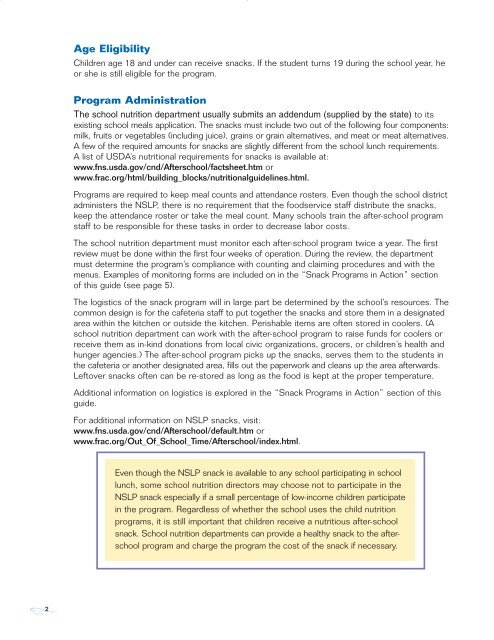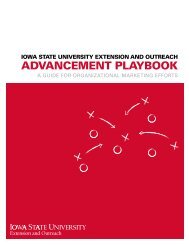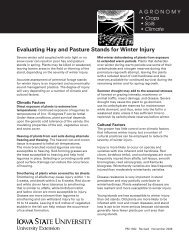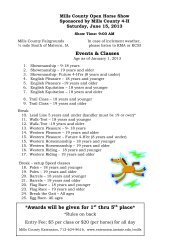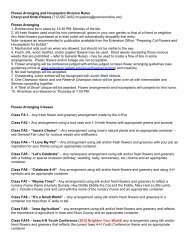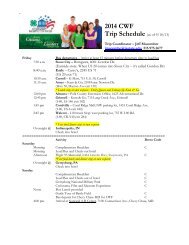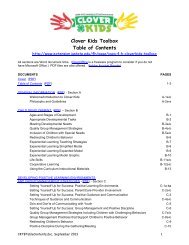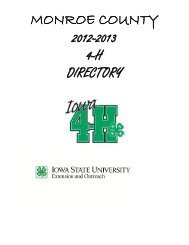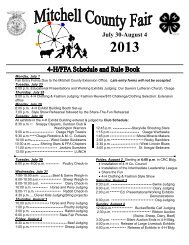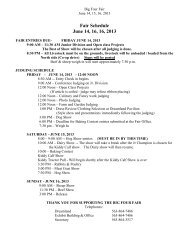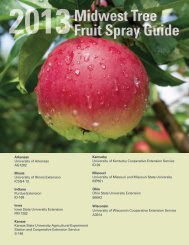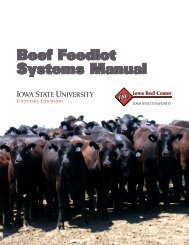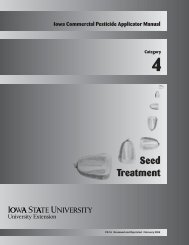Afterschool Snack Guide
Afterschool Snack Guide
Afterschool Snack Guide
Create successful ePaper yourself
Turn your PDF publications into a flip-book with our unique Google optimized e-Paper software.
2<br />
Age Eligibility<br />
Children age 18 and under can receive snacks. If the student turns 19 during the school year, he<br />
or she is still eligible for the program.<br />
Program Administration<br />
The school nutrition department usually submits an addendum (supplied by the state) to its<br />
existing school meals application. The snacks must include two out of the following four components:<br />
milk, fruits or vegetables (including juice), grains or grain alternatives, and meat or meat alternatives.<br />
A few of the required amounts for snacks are slightly different from the school lunch requirements.<br />
A list of USDA’s nutritional requirements for snacks is available at:<br />
www.fns.usda.gov/cnd/<strong>Afterschool</strong>/factsheet.htm or<br />
www.frac.org/html/building_blocks/nutritionalguidelines.html.<br />
Programs are required to keep meal counts and attendance rosters. Even though the school district<br />
administers the NSLP, there is no requirement that the foodservice staff distribute the snacks,<br />
keep the attendance roster or take the meal count. Many schools train the after-school program<br />
staff to be responsible for these tasks in order to decrease labor costs.<br />
The school nutrition department must monitor each after-school program twice a year. The first<br />
review must be done within the first four weeks of operation. During the review, the department<br />
must determine the program’s compliance with counting and claiming procedures and with the<br />
menus. Examples of monitoring forms are included on in the “<strong>Snack</strong> Programs in Action” section<br />
of this guide (see page 5).<br />
The logistics of the snack program will in large part be determined by the school’s resources. The<br />
common design is for the cafeteria staff to put together the snacks and store them in a designated<br />
area within the kitchen or outside the kitchen. Perishable items are often stored in coolers. (A<br />
school nutrition department can work with the after-school program to raise funds for coolers or<br />
receive them as in-kind donations from local civic organizations, grocers, or children’s health and<br />
hunger agencies.) The after-school program picks up the snacks, serves them to the students in<br />
the cafeteria or another designated area, fills out the paperwork and cleans up the area afterwards.<br />
Leftover snacks often can be re-stored as long as the food is kept at the proper temperature.<br />
Additional information on logistics is explored in the “<strong>Snack</strong> Programs in Action” section of this<br />
guide.<br />
For additional information on NSLP snacks, visit:<br />
www.fns.usda.gov/cnd/<strong>Afterschool</strong>/default.htm or<br />
www.frac.org/Out_Of_School_Time/<strong>Afterschool</strong>/index.html.<br />
Even though the NSLP snack is available to any school participating in school<br />
lunch, some school nutrition directors may choose not to participate in the<br />
NSLP snack especially if a small percentage of low-income children participate<br />
in the program. Regardless of whether the school uses the child nutrition<br />
programs, it is still important that children receive a nutritious after-school<br />
snack. School nutrition departments can provide a healthy snack to the afterschool<br />
program and charge the program the cost of the snack if necessary.


